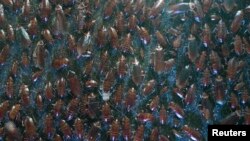Scientists are studying an ancient pathogen for clues as to how to fight a drug-resistant "superbug" in hospitals and other healthcare settings. They've found that resistance to modern antibiotics dates back millions of years.
Enterococci are one of a group of six bacteria known as "superbugs," microbes that infect patients and are resistant to antibiotics, making them potentially lethal.
Scientists studying the enterococcus family found they developed resistance to harsh conditions some 450 million years ago, well before dinosaurs came on the scene.
They say lesser animals deposited feces on land that contained bacteria that learned to survive harsh environmental conditions, such as drying by the sun.
Found in 30,000 year-old ice
The ancient “grandfather” of the bacterium, found frozen in 30,000-year-old ice, can be extracted and revived by modern scientists. That's how hardy enterococci are, according to Michael Gilmore, an ophthalmologist and microbiologist who heads Harvard University's extensive program on antibiotic resistance.
“The enterococci are sort of like the cockroach of bacteria. They're very, very difficult to kill. And so we think it's the traits that developed in enterococcus in order to survive on the land that are exactly what make them so rugged and able to survive now in hospitals,” said Gilmore.
Gilmore oversaw a team of researchers that sequenced the genomes of 24 members of the enterococci family, finding 45 different properties that make them resistant to antibiotics and disinfectants in modern hospitals.
Their work is described in the journal Cell.
Traced to Cambrian Explosion
By peering back into the bacteria's genetic material, investigators were able to trace enterococci's lineage to the Cambrian Explosion 542 million years ago when animals first emerged from the sea.
It was bacteria nestled in the intestines of crawling animals a million years later that developed resistance to their environment.
Gilmore said scientists are studying the pathogen's genes to identify targets for the development of new weapons to fight the superbug.
Gilmore added by characterizing the ancient DNA of enterococcus, "We can start looking at these different resistances and trying to identify for example new compounds that undermine those. So, those become the target set for the next generation of disinfectants or antibiotics."
Defenses are developed
Gilmore said enterococci live harmlessly in the digestive tracts of all animals along with thousands of other bacteria. In a hospital setting, people are often treated with antibiotics to prevent infections, but the drugs also kill helpful microorganisms that keep enterococci under control.
Without that check, the superbug, which is not killed off, develops resistance to the antibiotics. Overtime, Gilmore said it and other superbugs have developed defenses, including a tough outer layer, that make it difficult for antibiotics to penetrate.
Unhindered, the drug-resistant bacteria can find their way into the bloodstream or organs through wounds or the use of catheters. Once infected, patients, whose bodies are now overrun by superbugs, do not respond to antibiotics and can die of septic shock and organ failure.
Gilmore said the aim of research that traces enterococcus to its prehistoric origins is to take out this superbug that threatens hospitalized patients.







